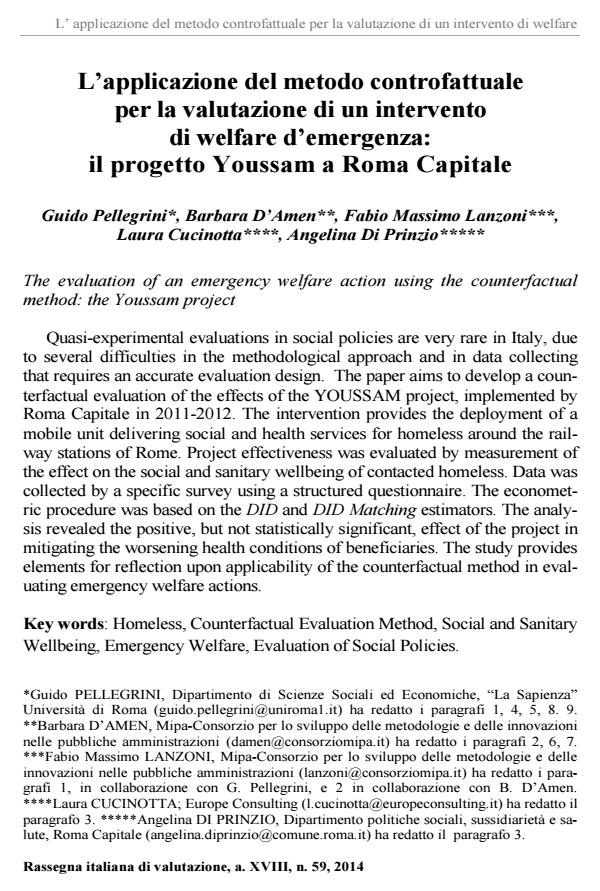The evaluation of an emergency welfare action using the counterfactual method: the Youssam project
Journal title RIV Rassegna Italiana di Valutazione
Author/s Guido Pellegrini, Barbara D'Amen, Fabio Massimo Lanzoni, Laura Cucinotta, Angelina Di Prinzio
Publishing Year 2015 Issue 2014/59 Language Italian
Pages 24 P. 124-147 File size 181 KB
DOI 10.3280/RIV2014-059007
DOI is like a bar code for intellectual property: to have more infomation
click here
Below, you can see the article first page
If you want to buy this article in PDF format, you can do it, following the instructions to buy download credits

FrancoAngeli is member of Publishers International Linking Association, Inc (PILA), a not-for-profit association which run the CrossRef service enabling links to and from online scholarly content.
Quasi-experimental evaluations in social policies are very rare in Italy, due to several difficulties in the methodological approach and in data collecting that requires an accurate evaluation design. The paper aims to develop a counterfactual evaluation of the effects of the YOUSSAM project, implemented by Roma Capitale in 2011-2012. The intervention provides the deployment of a mobile unit delivering social and health services for homeless around the railway stations of Rome. Project effectiveness was evaluated by measurement of the effect on the social and sanitary wellbeing of contacted homeless. Data was collected by a specific survey using a structured questionnaire. The econometric procedure was based on the DID and DID Matching estimators. The analysis revealed the positive, but not statistically significant, effect of the project in mitigating the worsening health conditions of beneficiaries. The study provides elements for reflection upon applicability of the counterfactual method in evaluating emergency welfare actions.
Keywords: Homeless, Counterfactual Evaluation Method, Social and Sanitary Wellbeing, Emergency Welfare, Evaluation of Social Policies
- Battiloro V., Mo Costabella L. (2011). Incentivi o misure di attivazione? Evidenze sull’efficacia di due interventi per contrastare il lavoro precario. Politica Economica, 2: 197-218. DOI: 10.1429/35198
- Blundell R., Costa Dias M. (2009). Alternative Approaches to Evaluation in Empirical Microeconomics. Journal of Human Resources, 3: 565-640. DOI 10.1353/jhr.2009.0009.
- Ciaranello A. L., Molitor F., Leamon M., Kuenneth C., Tancredi D., Diamant A. L., Kravitz, R. (2006). Providing health care services to the formerly homeless: a quasi-experimental evaluation. Journal of Health Care for the Poor and Underserved, 17: 441-461. DOI: 10.1353/hpu.2006.0056
- De Paola M., Scoppa V. e Nisticò R., (2012). Monetary Incentives and Student Achievement in a Depressed Labour Market: Results from a Randomized Experiment. Journal of Human Capital, 1: 56-85. DOI: 10.1086/664795
- Del Zotto S. (2011). EU Provisions and Recent Developments Relevant to Health and Homelessness. Homelss in Europe, 1: 4-6. Articolo disponibile al sito http://www.feantsa.org/spip.php?rubrique40&lang=en (data di consultazione: 20 ottobre 2013).
- Driver C., Urga G. (2004). Transforming Qualitative Survey Data: Performance Comparisons for the UK.. Oxford Bulletin of Economics and Statistics, Department of Economics, University of Oxford, vol. 66 (1): 71-89. DOI: 10.1111/j.1468-0084.2004.00070.
- Fitzpatrick K. M., (2013). Poverty and Health. A crisis among American’s Most Vulnerable, Vol. 2. Santa Barbara: ABC-CLIO.
- Fitzpatrick-Lewis D., Ganann R., Krishnaratne S., Ciliska D., Kouyoumdjian F., Hwang S. W. (2011). Effectiveness of interventions to improve the health and housing status of homeless people: a rapid systematic review. Public Health, 11:638-652. DOI: 10.1186/1471-2458-11-638
- Hwang S. W., Tolomiczenko G., Kouyoumdjian F. G., Garner R. E. (2005). Interventions to Improve the Health of the Homeless. A Systematic Review. American Journal of Preventive Medicine, 29: 311-319. DOI: 10.1016/j.amepre.2005.06.017
- Loehnert S. (2010). About Statistical Analysis of Qualitative Survey Data. International Journal of Quality, Statistics, and Reliability, Volume 2010. DOI: 10.1155/2010/849043
- Martini A., Trivellato U. (2011). Sono soldi ben spesi? Perché e come valutare l’efficacia delle politiche pubbliche. Venezia: Marsilio Editori
- Ministero del Lavoro, della Salute e delle Politiche Sociali (2007) Classificazione delle malattie, dei traumatismi, degli interventi chirurgici e delle procedure diagnostiche e terapeutiche. Testo disponibile
- al sito http://www.asl.vt.it/Ospedaliera/DirSanPOC/Documentazione/ICD-9-CM_2007.pdf (data di consultazione: 25 ottobre 2013).
- Morse GA, Calsyn RJ, Allen G, Tempelhoff B, Smith R. (1992). Experimental comparison of the effects of three treatment programs for homeless mentally ill people. Hosp Community Psychiatry; 43: 1005-10.
- Nyamathi AM, Christiani A, Nahid P, Gregerson P, Leake B. (2006). A randomized controlled trial of two treatment programs for homeless adults with latent tuberculosis infection. The International Journal of Tuberculosis and Lung Disease, 10:775-782.
- OMS (1995). Lexicon of alcohol and drug terms, Organizzazione mondiale della sanità, Ginevra.
- Power R., French R., Connelly J., George S., Hawes D., Hinton T., Klee H., Robinson D., Senior J., Timms P., Warner D. (1999). Promoting the health of homeless people. Setting a research agenda. Testo disponibile al sito (data di consultazione: 5 ottobre 2013).www.nice.org.uk/nicemedia/documents/promohealth_homeless.pdf
- Redelmeier DA, Molin JP, Tibshirani RJ. (1995) A randomised trial of compassionate care for the homeless in an emergency department. The Lancet, 345:1131–4. DOI: 10.1016/S0140-6736(95)90975-3
- Rubin D. B. (1974). Estimating causal effects of treatments in randomized and nonrandomized studies. Journal of Educational Psychology, 66: 688-701. DOI: 10.1037/h0037350
- Santarsiero S, Sisti M. (2013). L’offerta di servizi multipli a famiglie indigenti con figli piccoli conduce all’autosufficienza economica?”. Testo disponibile al sito http://www.capire.org/capireinforma/scaffale/valut-azione15092013.pdf (data di consultazione: 10 ottobre 2013).
Guido Pellegrini, Barbara D'Amen, Fabio Massimo Lanzoni, Laura Cucinotta, Angelina Di Prinzio, L’applicazione del metodo controfattuale per la valutazione di un intervento di welfare d’emergenza: il progetto Youssam a Roma Capitale in "RIV Rassegna Italiana di Valutazione" 59/2014, pp 124-147, DOI: 10.3280/RIV2014-059007